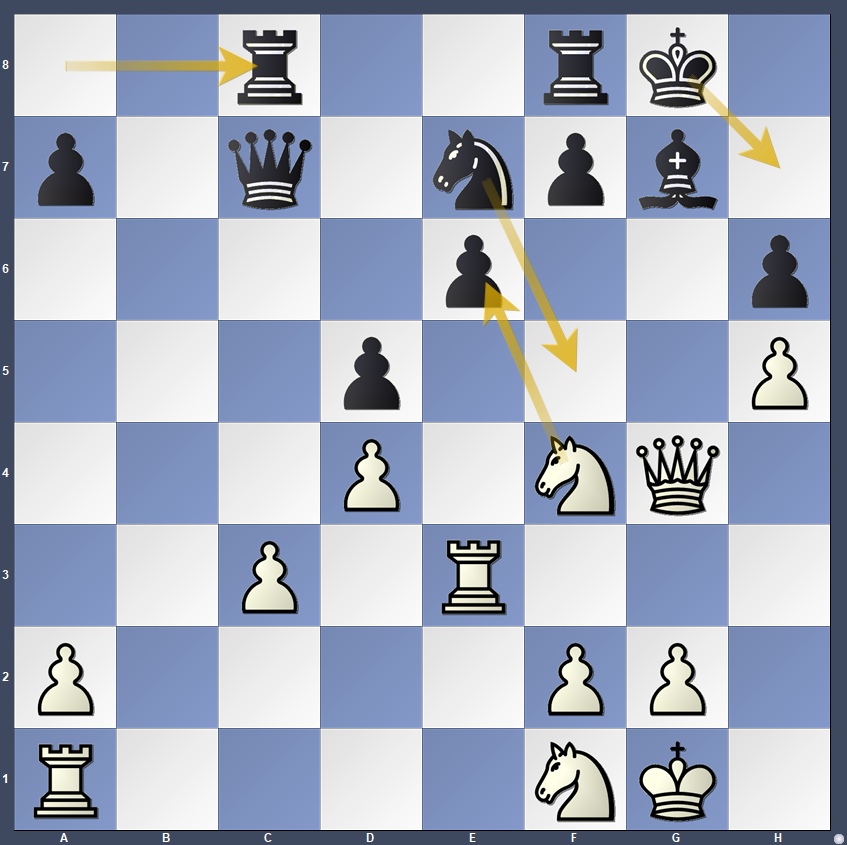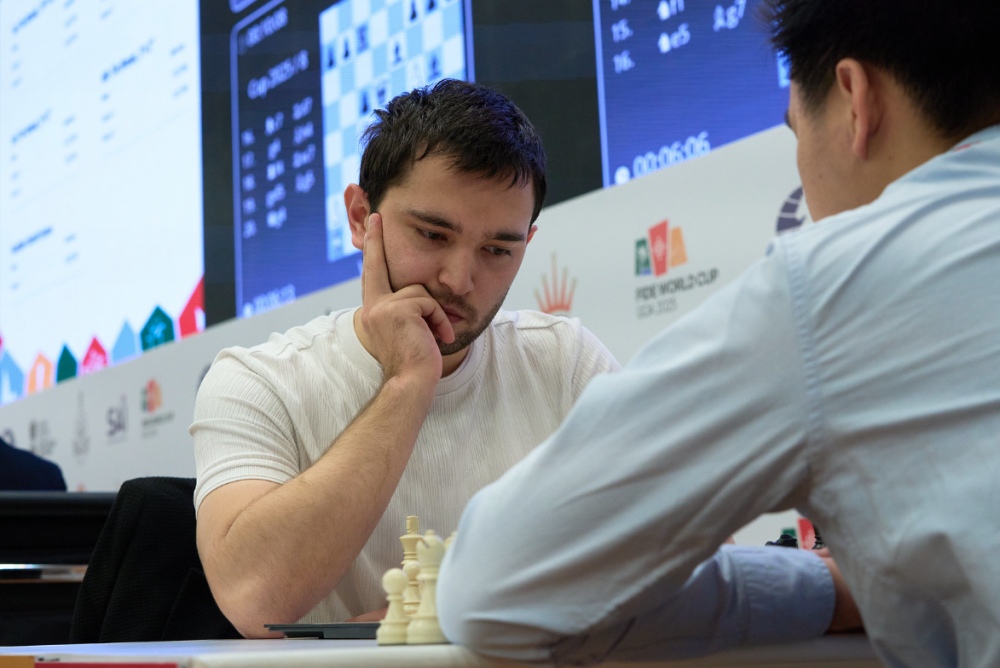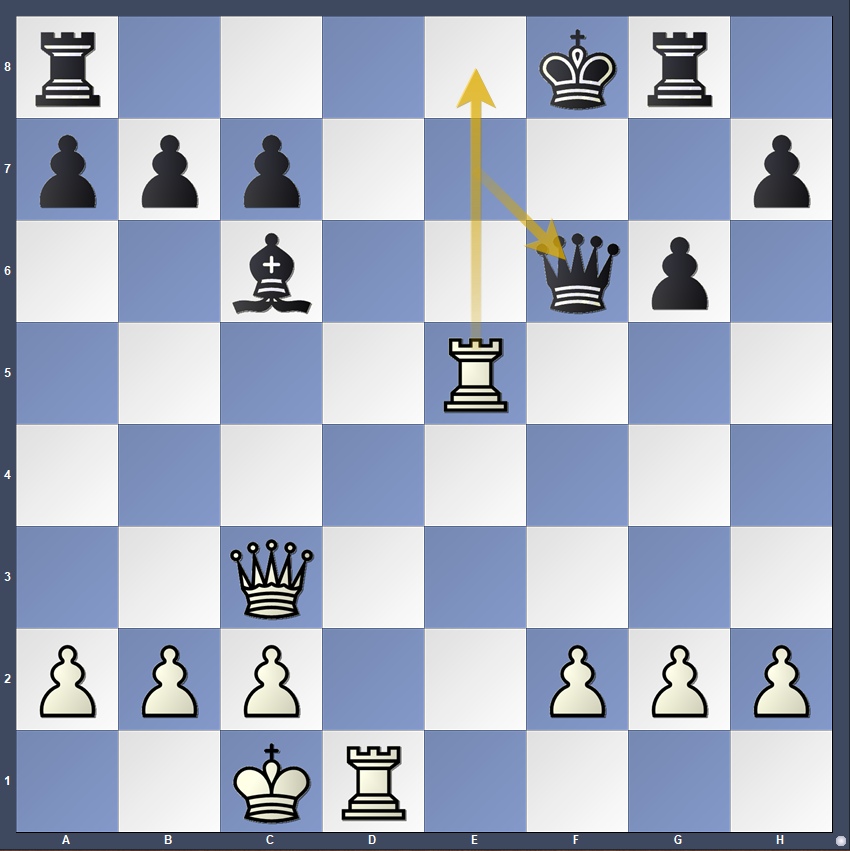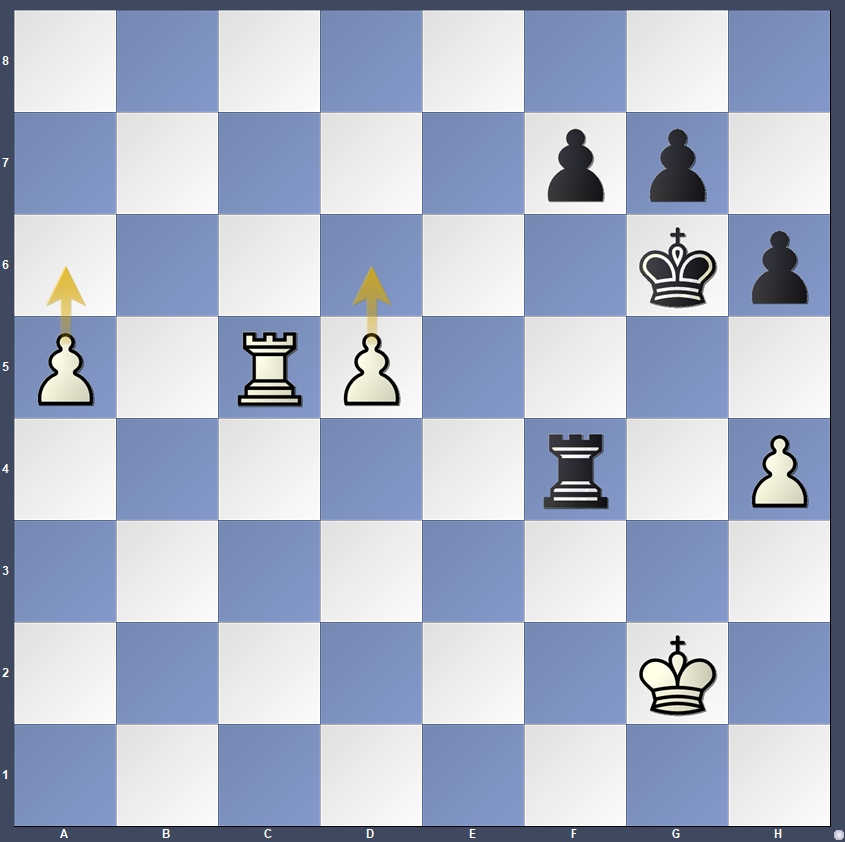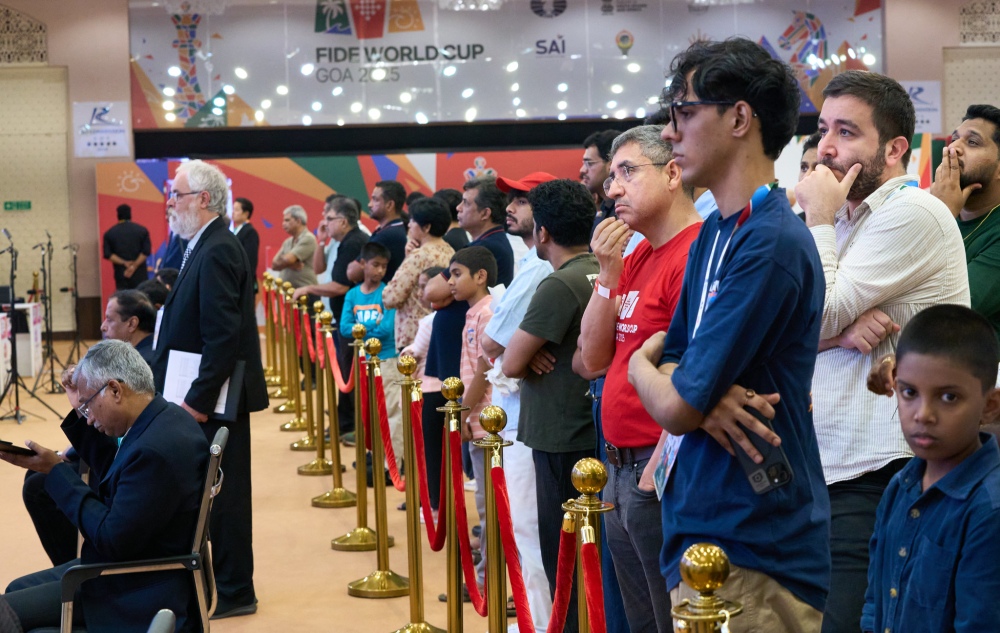
The 2025 FIDE World Cup continued to deliver high drama in Goa, as Round 3 tiebreaks produced a day filled with tension, brilliance, and heartbreak in equal measure. With places in the final 32 – and the Candidates qualification dream – on the line, nerves ran high across the playing hall. Every move carried enormous weight; a single mistake could mean the end of a months-long journey.
In a recent podcast, World No. 3 Fabiano Caruana, already qualified for the Candidates, reflected on the nature of tiebreaks: “The better player usually wins.” As the clock speeds up, he explained, experience, composure, and precision tend to outweigh creative risks. That idea proved prophetic in Goa, as five of the six players rated above 2700 ultimately prevailed, their class showing through when the pressure was at its peak.
The day’s results reinforced an enduring truth of knockout chess: when time dwindles and tension mounts, the difference between victory and elimination often lies not in preparation, but in psychology. Some players cracked under the relentless rhythm of rapid and blitz play; others thrived, finding clarity amid chaos. The crowd inside the playing venue could sense it – every board seemed to pulse with intensity.
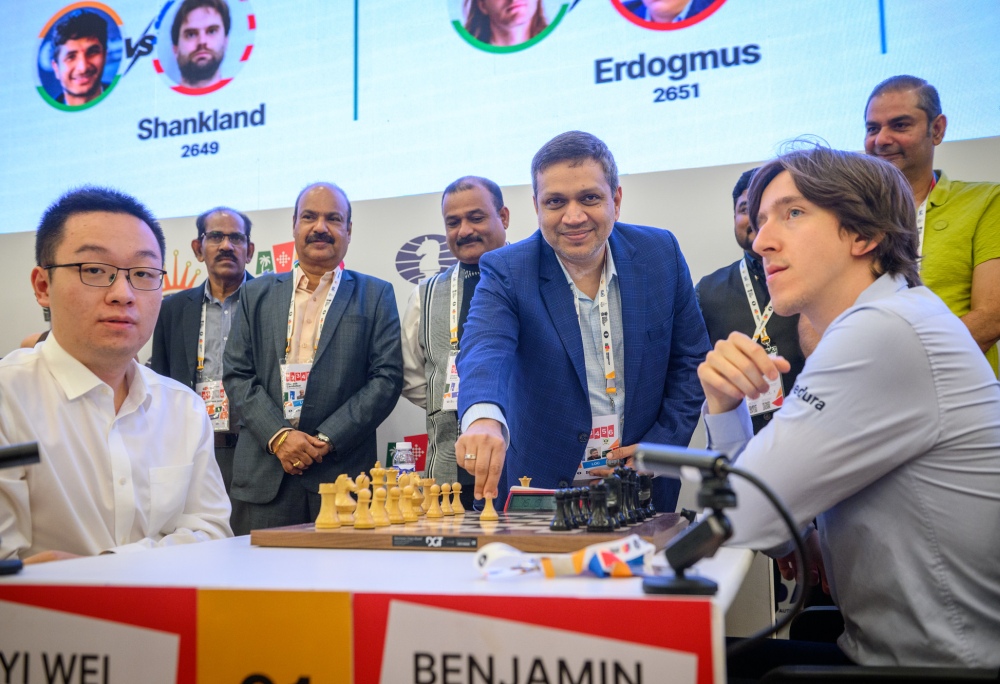
The round began with the ceremonial first move performed by GM Abhijit Kunte, India’s 4th Grandmaster (after Anand, Barua, and Harikrishna) and the Tournament Director of the World Cup.
Born in Pune, Maharashtra, in 1977, Kunte was a true pioneer of Indian chess during the late 1990s and early 2000s – a player known for his classical style, deep positional understanding, and his lasting contributions as both coach and mentor.
Three of the eleven tiebreaks were decided swiftly, ending after the first 15+10 rapid segment with clean 2–0 victories.
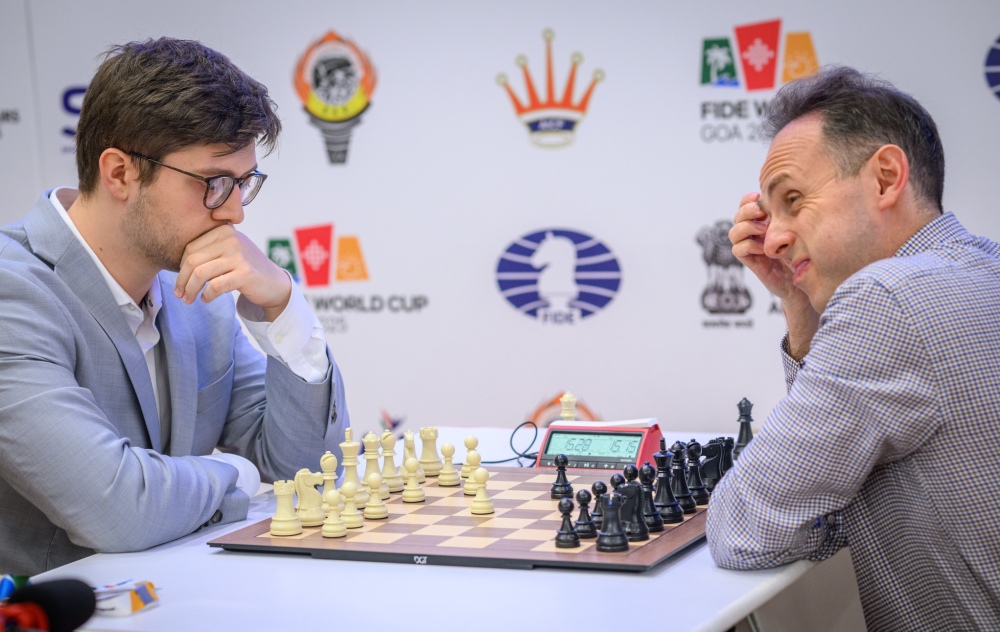
The first player to book his ticket to the fourth round was GM Samuel Sevian, the American prodigy who once became the youngest grandmaster in U.S. history at just 13 years and 10 months. Known for his dynamic and fearless style, Sevian thrives in sharp middlegame battles where calculation and courage go hand in hand.
Now hovering just below the 2700 rating mark, Sevian has been particularly impressive in rapid formats. After dispatching GM Tin Jingyao (2583) of Singapore in the second round tiebreaks, he repeated the feat today – drawing both classical games before convincingly defeating GM Evgeniy Najer (2610) in two rapid encounters.
He shared his thoughts in a short but insightful post-game interview – don’t miss it!
Not long after, I spotted GM Alexey Sarana (2661) leaving the playing venue with a broad smile — and a quick check confirmed why. He had just secured victory in both of his rapid games against GM Jorden Van Foreest (2697), earning his place in the fourth round.
A former European Champion (2023) and a player who often hovers around the 2700 mark, the Serbian grandmaster is widely recognized for his technical precision and deep preparation. It had been a hard-fought match: after trading wins in the classical games, Sarana’s superior technique in a series of minor-piece endgames proved decisive in the rapid segment.
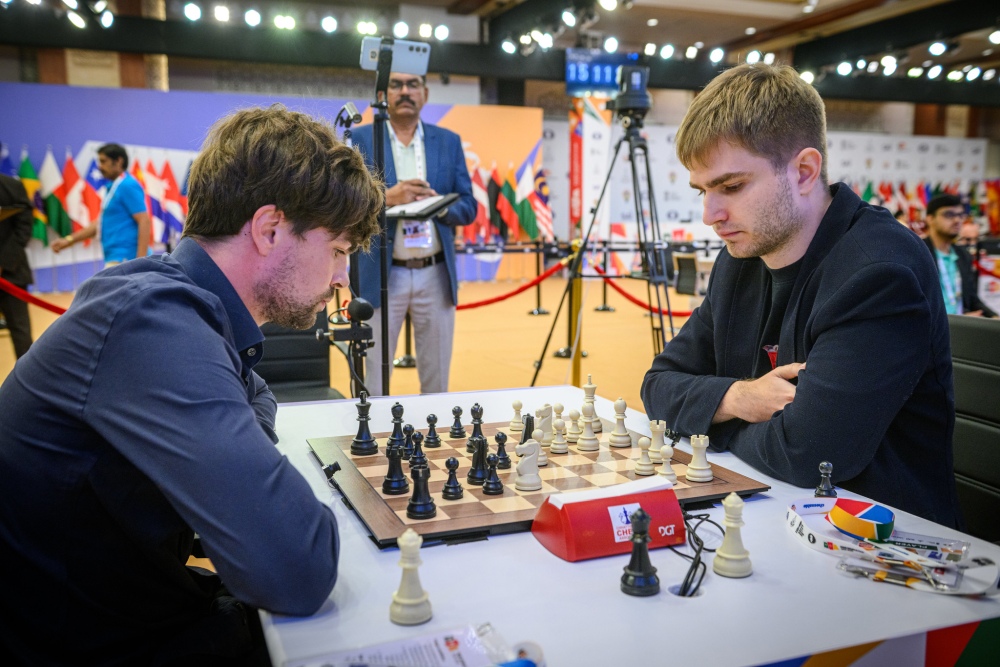
FIDE’s interview specialist Charlize van Zyl caught up with him moments later for his thoughts on the event.
“It’s a very tough tournament, and I try to take it match by match — because even in the first round, you can lose and be out,” Sarana reflected. “This tournament only happens once every two years, so it’s hard to predict anything, but of course the goal is to go as far as possible. As for the format, I think this is the most interesting tournament both to play and to watch. It’s very tense, but also very exciting — I really like the World Cup.”
The third player to advance to the fourth round with a perfect 2–0 score in the first rapid segment was GM Nodirbek Yakubboev of Uzbekistan (rated 2689). Born in 2002, Yakubboev is one of the brightest talents in Uzbek chess and a cornerstone of the national team that captured gold at the 2022 Chess Olympiad in Chennai. A three-time Uzbek national champion, he is known for his calm, classical style, backed by deep opening preparation and remarkable resilience under pressure.
After two solid draws in the classical portion against GM Thai Dai Van Nguyen (2664), Yakubboev capitalized on a brief lapse in concentration from his opponent in the second rapid game – enough to secure the win and a spot among the final 32 contenders.
Black had just played 23…Rac8? – a serious mistake in an otherwise balanced position. Both 23…Kh7 and 23…Nf5 would have kept the game roughly equal, but this slip proved fatal. Yakubboev immediately pounced with the tactical shot 24.Rxe6!, the key idea being that 24…fxe6 loses to 25.Nxe6, simultaneously attacking the queen and threatening checkmate on g7.
Shocked by the sudden turn of events, Nguyen spent a couple of minutes searching for defensive resources. He could have tried 24…Qd7, but instead opted for 24…Qxc3, which failed to the deadly 25.Rxe7 – the rook on a1 cannot be taken due to 25.Ne6! With this victory Yakubboev comfortably advanced to Round 4.
Four more players also qualified for the next round with 1.5–0.5 match victories. Among them was GM Richard Rapport (2724), who ended the impressive run of Turkey’s young star, GM Yagiz Kaan Erdogmus (2651). Despite holding his ground in both classical games – no small feat against such a formidable opponent – Erdogmus ultimately bowed out, leaving Goa with a wealth of experience and confidence for future events.
Rapport, meanwhile, displayed the trademark class that has made him one of the most admired figures in modern chess. He ground down his opponent in the first rapid game through a long technical endgame, then showed precise defensive technique in the second, holding his ground in the tricky rook and bishop versus rook ending.
Born in 1996 in Szombathely, Hungary, Rapport is celebrated for his creativity and originality, his unorthodox openings, and his fearless, artistic approach to the game – qualities that could very well fuel another deep run toward the Candidates.
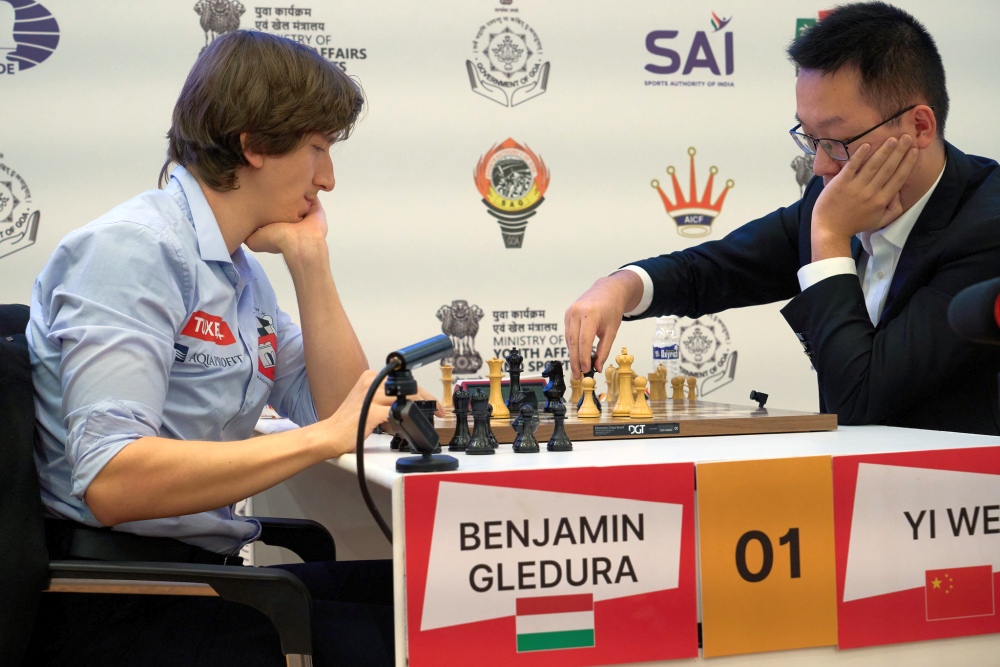
Chinese GM Wei Yi (2754) displayed superb endgame technique in his two rapid games against Hungarian GM Benjamin Gledura (2643) and secured his place in the next round. One of China’s leading grandmasters and among the most gifted players of his generation, Wei Yi is renowned for his brilliant attacking style, creative ideas, and deep calculation.
In his post-game interview, Wei Yi admitted that the match had been anything but easy.
“Both of the classical games were solid and ended in draws,” he explained. “He was slightly better in the first tiebreak game and even had some chances to push for a win, but he blundered badly in time pressure during the endgame. I try not to get nervous, but here I’ve felt nervous in many games — it’s not so easy.”
Indian GM Karthik Venkataraman (2579) and Chinese GM Yu Yangyi (2720) were the other two players to secure qualification during the first rapid segment. In the case of Yu Yangyi, his compatriot Wei Yi wasn’t surprised by the result – noting in his interview that Yu is “very strong in rapid tiebreaks” and that the two often support each other as teammates. Given his vast experience and composure under pressure, it’s no surprise that Yu continues to advance confidently through the event.
The final four matches extended into the 10+10 rapid segment, a testament to the resilience and evenly matched strength of the remaining contenders. Three of these encounters were decided at this stage.
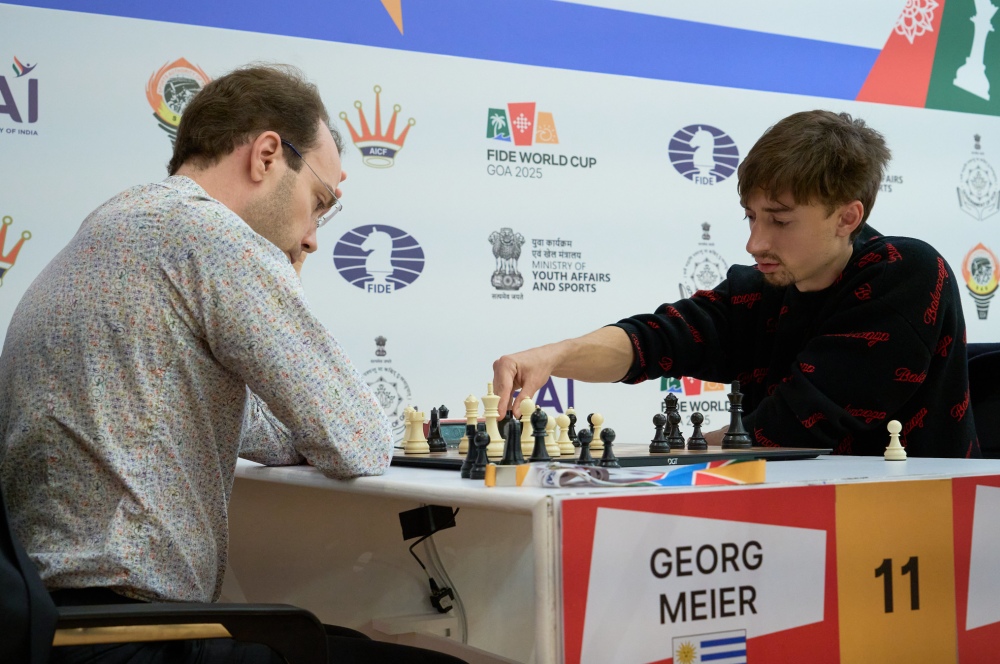
One of the most hard-fought duels of the entire round was the clash between GM Daniil Dubov (2684) and GM Georg Meier (2596). All four of their initial game – the two classical and the two 15+10 rapid encounters – ended in draws, the fourth of them after just six moves, a curious breather before the real battle resumed.
In the first of the 10+10 games, Meier erred fatally with 22…Qf6??. Despite being a piece up, his king was suddenly exposed to a decisive tactical assault. Dubov struck immediately with 23.Re8+!, taking advantage of the now-hanging queen on f6, and after 23…Kf7 24.Qc4+!, the game was effectively over – 24…Kg7 loses instantly to 25.Qxg8. Meier resigned soon after, and although he fought valiantly in the return game, there was no way back.
GM Andrey Esipenko (2693) is one of the most talented representatives of the world’s elite young generation. Known for his deep opening preparation, universal style, and calm demeanour at the board, Esipenko combines classical principles with modern precision.
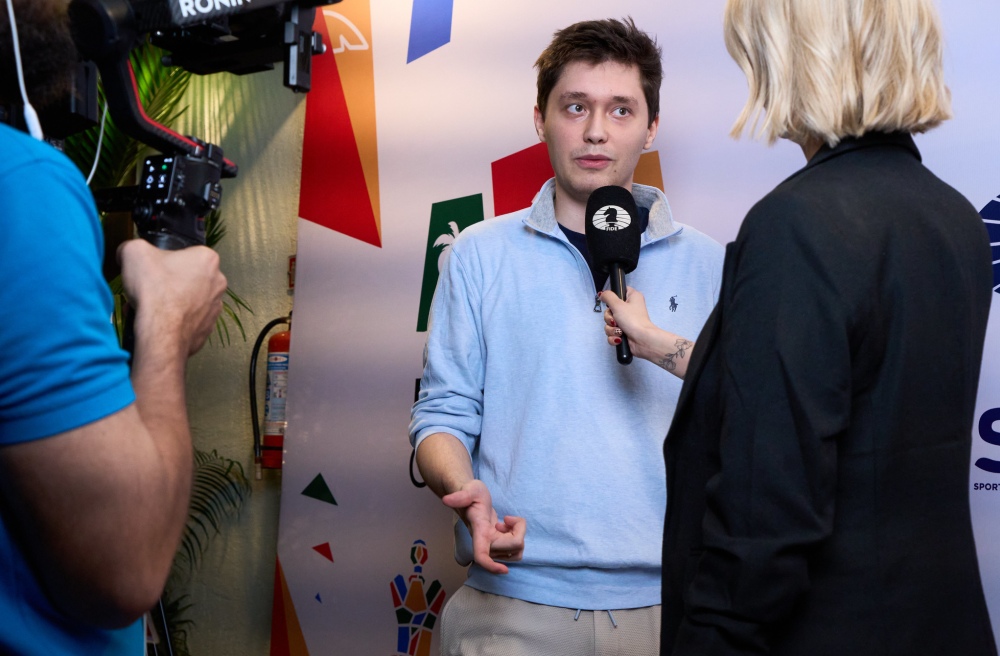
That composure proved vital in his hard-fought match against Iran’s GM Pouya Idani (2601) – a resilient and resourceful opponent. After losing the first classical game, Esipenko struck back in the second to level the score, and from there gradually took control. He won the first rapid game and, when the match reached the second 10+10 stage, proved once again to be the steadier player, securing his place in the fourth round.
Meanwhile, another +2700-grandmaster bowed out of the tournament – local hero GM Vidit Gujrathi (2716). The 2023 Grand Prix winner, known for his deep preparation, disciplined approach, and calm presence at the board, was eliminated by American GM Sam Shankland (2654) in a dramatic and unpredictable match that could have gone either way.
Born in Nashik, Maharashtra, Vidit has been one of the key figures in India’s modern chess rise. One of the critical moments came in the first rapid game, where Vidit seized the initiative and briefly led the match – but Shankland’s resilience and endgame mastery turned the tide in the end.
After a long and nerve-wracking struggle, with both players under extreme time pressure, it was Shankland who faltered first. He played the hasty 64.c6?, allowing Vidit to immediately seize control with 64…Qe2+ 65.Kc3 b4+!. Now, after 66.Nxb4 Qc4+!, White’s position collapses; in the game, 66.Kxb4 Qxd3 followed by …Qc4+ and …Ne7 securely blockaded the c-pawn, forcing resignation a few moves later.
The correct idea for the American would have been 64.Qb8+ Kf7 65.Qb7+ Ne7 66.c6, when the queen on b7 protects the b-pawn’s advance and keeps the balance — a probable draw.
However, Shankland showed remarkable resilience, striking back in the second rapid game and ultimately clinching victory in the 10+10 stage to eliminate Vidit. Interviewer Charlize van Zyl caught up with the relieved American just as he was leaving the playing venue for a brief post-game chat.
GM Maxime Vachier-Lagrave (2737) became the hero of the day, coming back on the scoreboard twice over the course of an exhausting eleven-game match to finally eliminate GM Vladislav Artemiev (2646) — himself a renowned rapid and blitz specialist and a former 2700-rated player. It was a thrilling back-and-forth battle, filled with sharp positions and mutual time pressure, where both players demonstrated exceptional defensive skills and nerves of steel. One of the most interesting moments of the match was played in the rapid segment.
In this position, Vachier-Lagrave played 51.d6?, missing the win after Black’s correct 51…Rd4!. The correct path was 51.a6! Ra4, and now the brilliant, only move 52.Rc8! — after which Black cannot prevent the rook from protecting the pawn via Ra8 on the next move, allowing White to advance the d-pawn to victory.
The key tactical point is that 52.Rc8 Rxa6 fails to 53.Rc6+!, exchanging rooks and heading into a trivially won pawn ending.

Commentating from the broadcast studio, GM Anish Giri remarked that, with so little time on the clock, this resource was understandably easy to miss: “It’s counterintuitive to push the a-pawn and apparently lose it.”
The match itself was pure drama — an eleven-game rollercoaster that ended in an Armageddon showdown. MVL bid 2.48 seconds, while Artemiev went even lower with 2.40, gaining draw odds with Black. Maxime kept his cool, maintained a time edge throughout, and ultimately clinched the win. “This was a great match. Congratulations to Vlad — it took all I had to come back and win it. Of course, I feel relieved, but the event is still very long,” said the Frenchman moments after sealing victory.
As the sun set over Goa, the tension of the third-round tiebreaks finally gave way to relief and reflection. Precision, nerve, and endurance defined the day — qualities that separated those moving forward from those heading home. For the heavyweights, experience proved decisive; for the rising stars, it was another step toward belonging among the world’s elite. With only 32 players now remaining, the 2025 FIDE World Cup enters its most gripping phase — where every move, every second, and every decision could define a career.
Although all sixteen Round 4 matches promise excitement in their own right, here are five encounters that stand out as must-watch clashes:
Erigaisi vs Leko
Praggnanandhaa vs Dubov
Keymer vs Esipenko
Rapport vs Shankland
Sindarov vs Yu Yangyi
Round 4 parings can be found [HERE]
Tomorrow November 10 is the first rest day of the event. Game 1 of Round 4 will be played on November 11, starting at 3 PM local time.
The action can be followed live on the FIDE YouTube Channel, featuring expert commentary by GMs Evgenij Miroshnichenko and Jan Gustafsson.
To watch the games in person, tickets can be purchased [HERE]
Official website: worldcup2025.fide.com/
Written by IM Michael Rahal
Photos: Michal Walusza and Eteri Kublashvili



